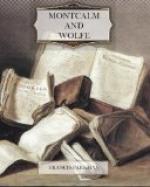[Footnote 523: This is stated by Pouchot and Bougainville; the latter of whom confirms the testimony of the English witnesses, that Canadian officers present did nothing to check the Indians.]
[Footnote 524: See note, end of chapter.]
[Footnote 525: Belknap, History of New Hampshire, says that eighty were killed. Governor Wentworth, writing immediately after the event, says “killed or captivated.”]
The bonds of discipline seem for the time to have been completely broken; for while Montcalm and his chief officers used every effort to restore order, even at the risk of their lives, many other officers, chiefly of the militia, failed atrociously to do their duty. How many English were killed it is impossible to tell with exactness. Roubaud says that he saw forty or fifty corpses scattered about the field. Levis says fifty; which does not include the sick and wounded before murdered in the camp and fort. It is certain that six or seven hundred persons were carried off, stripped, and otherwise maltreated. Montcalm succeeded in recovering more than four hundred of them in the course of the day; and many of the French officers did what they could to relieve their wants by buying back from their captors the clothing that had been torn from them. Many of the fugitives had taken refuge in the fort, whither Monro himself had gone to demand protection for his followers; and here Roubaud presently found a crowd of half-frenzied women, crying in anguish for husbands and children. All the refugees and redeemed prisoners were afterwards conducted to the entrenched camp, where food and shelter were provided for them and a strong guard set for their protection until the fifteenth, when they were sent under an escort to Fort Edward. Here cannon had been fired at intervals to guide those who had fled to the woods, whence they came dropping in from day to day, half dead with famine.




